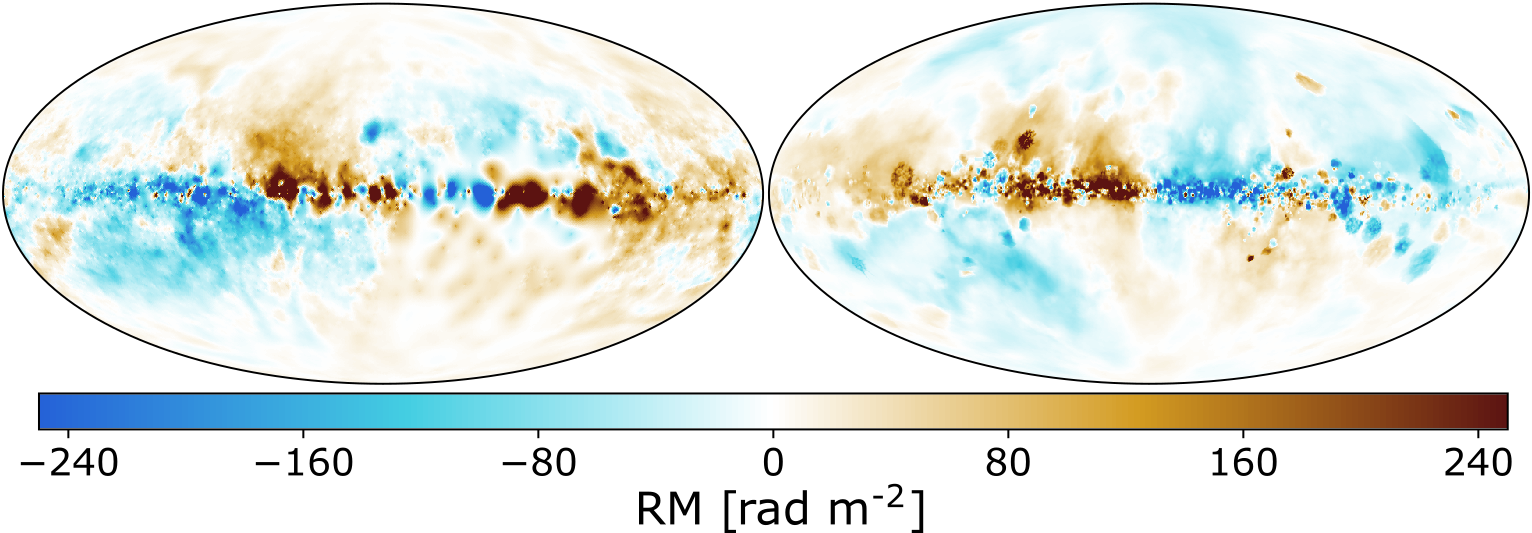A reproduction of the Milky Way’s Faraday rotation measure map in galaxy simulations from global to local scales
Published in Astronomy
Introduction
Magnetic fields play a significant role in shaping the kinematic and morphological attributes of the interstellar medium (ISM), affecting the process of star formation within the Milky Way (MW) galaxy. These magnetic fields are instrumental in the dynamic evolution of the ISM and exert a pivotal influence on the mechanisms underlying star formation. Measurements of Faraday rotation along various sightlines across the Galaxy serve as a fundamental approach for deducing magnetic field morphology and strengths from observational data. However, interpreting this data has been hindered by challenges in generating a comprehensive multi-scale, all-sky Faraday rotation measure (RM) map. Since the 1960s, numerous endeavors have been made to construct such a map by observing pulsars and extragalactic background sources. Complementary synthetic data has proven valuable in systematically interpreting and analyzing such observations. Although the large-scale properties are generally well defined, essential insights into specific star-forming regions and cloud structures are lacking, which are crucial for explaining the observed MW small-scale features.

Research Methodology
Our research goes beyond current state-of-the-art methods by integrating high-resolution cosmological simulations with a novel star cluster population synthesis model. This combination allows us to reconstruct both the large-scale properties of the MW galaxy and the missing small-scale physics. In detail, we create a synthetic all-sky Faraday RM map of the MW by post-processing the galaxy labeled "Au-6" from the Auriga project. This galaxy closely mimics the MW's global star-formation rate and structure while predicting the amplification of primordial magnetic seed fields to micro-Gauss strength over extended timescales. Galaxy Au-6 results from a high-resolution cosmological magnetohydrodynamic (MHD) zoom-in simulation, starting from initial conditions chosen to replicate essential features of the Local Group. Contemporary galaxy formation and evolution simulations accurately reproduce observed large-scale magnetic field configurations, encompassing both field strength and morphology.
We apply an algorithm for synthesizing new star cluster populations and electron fractions that adhere more closely to star-forming physics and small-scale density structures as found in observations. We replace the original simulation-based star particles and electron fractions with data generated from the WARPFIELD cloud/cluster evolution model. This model tracks the temporal evolution and structure of the stellar wind bubble, HII region, and photodissociation region surrounding a cluster of massive stars in spherical symmetry. The model incorporates the physics of stellar winds, supernovae, radiation pressure, ionization, and gravity in a self-consistent manner, resulting in a realistic stellar population characterized by the number of stellar clusters. The spectral synthesis code CLOUDY is used to compute the physical properties and emission characteristics of each cluster.
We calculate the impact of ionizing radiation from individual clusters on the Galactic ISM, consequently repopulating the entire Au-6 galaxy with a new distribution of thermal electrons assuming solar metallicity, cosmic ray ionization rates, and an interstellar radiation field to be representative for the MW. With this approach, we obtain all parameters necessary to compute synthetic RM maps for the MW analog Au-6 with the radiative transfer code POLARIS. The synthetic Faraday RM all-sky maps are calculated from ten selected observer positions within the Au-6 galaxy for many different sightlines across the entire galaxy and covering the entire sky with high angular resolution on a HEALPIX sphere. The location of the fictitious observers in the Au-6 galaxy are selected such that the distance to the galactic center is close to the solar distance being 8.5 kpc, and that they are placed in a Local Bubble like region, where previous supernovae have created a low-density gas cavity.
Findings
Existing RM all-sky maps of the MW are typically derived from a collection of extragalactic polarized radio sources. Regions with incomplete or reduced data coverage are reconstructed through Bayesian statistics, leading to smoother appearances compared to the average. Furthermore, synthetic maps based solely on the original Au-6 galaxy and its unprocessed electron distribution fail to capture small-scale features observed within the MW. Our innovative approach, employing a cosmological MHD simulation of MW formation supplemented by a star cluster population synthesis model for a more accurate portrayal of the local interstellar medium, produces a highly precise Faraday sky prediction as observed from Earth.
The synthetic data aligns remarkably well with Galaxy observations both on a global scale and within individual star-forming clouds. In detail, the full model exhibits comparable fluctuations on small angular scales and accurately predicts RM magnitudes across all regions. Notably, the RM maps show a reversal of magnetic field direction at the Galactic center, evidenced by a transition from positive to negative RM values, indicative of a globally toroidal field structure akin to that of the MW. Additionally, we perform a multipole expansion analysis of the RM maps, yielding a quantitative comparison. Our synthetic RM spectra align with observations for multipole moments l<30, while slight deviations occur at smaller scales with I>30. We acknowledge that actual RM observations may underestimate power at larger moments due to potential biases towards small RM values, potentially overlooking significant local variations, such as those seen in HI observations. This bias could result from the Bayesian statistics applied to the observational data.
Furthermore, our results suggest that the Local Bubble encompassing our Solar System predominates the RM signal over extensive sky regions.
Conclusion
In summary, modern cosmological MHD simulations of MW formation, combined with ab-initio modeling of star formation, stellar feedback, and distribution of free electrons within the ISM, effectively elucidate the structures observed in RM data. This comprehensive approach to generating synthetic RM observations contributes significantly to our comprehension of the origin of magnetic fields within our Galaxy.
The complete publication will soon be accessible in Nature Astronomy.




Please sign in or register for FREE
If you are a registered user on Research Communities by Springer Nature, please sign in